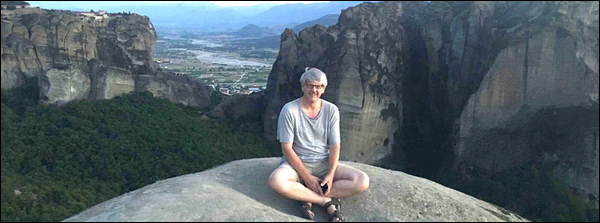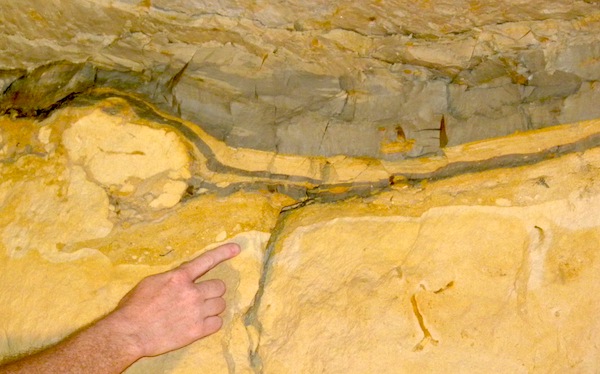Pressum
Diem
Guy
McPherson
31
December, 2018

“I,
myself, doubt that many people reading these words have three years
to live. Habitat for humans on Earth will disappear shortly after the
Arctic ice is gone, which is likely to occur in the summer of 2019.
Three decades is a pipe dream to be experienced by no humans on
Earth.”—Guy
McPherson
Going
Dark
By
Dr. Guy McPherson

The
K-Pg Boundary, all that remains of the burgeoning life on Earth
prior to the Cretaceous-Paleogene Extinction Event.
 WESTCHESTER
COUNTY New York—(Weekly Hubris)—January 2019—Imagine
you’re listening to the radio as you gaze at the horizon out your
fourth-floor window. You see a mushroom cloud and immediately
recognize it. You realize that the 20-foot-long I-beam spinning
toward you will strike you dead in three seconds. There is no way to
escape.
WESTCHESTER
COUNTY New York—(Weekly Hubris)—January 2019—Imagine
you’re listening to the radio as you gaze at the horizon out your
fourth-floor window. You see a mushroom cloud and immediately
recognize it. You realize that the 20-foot-long I-beam spinning
toward you will strike you dead in three seconds. There is no way to
escape.
You simply wait.
But
. . . you have miscalculated the path of the I-beam. It sails clear,
narrowly missing the roof above your head.
A
voice on the radio announces the bomb blast will level everything in
your city within three minutes. Compared to three seconds, three
minutes seems like an eternity. What will you do with the time? Make
a telephone call? Make peace with your god(s)?
Now,
imagine a trip to a medical doctor. He matter-of-factly informs you
that your condition gives you only three minutes to live. He leaves
you alone with your thoughts. You ponder your life and wonder how to
proceed. You think about calling somebody. Or maybe you take a few
deep breaths, instead.
The
doctor re-enters the examination room after two minutes and 30
seconds. He apologizes for his error and says you have about
three hours to live, not three minutes. You breathe
a sigh of relief. Three hours seems a long time compared to three
minutes. You can make a few calls, pen a quick will, and record some
thoughts for posterity.
Rinse
and repeat for a diagnosis of three days versus three hours. And
then, for three weeks as opposed to three days. Three weeks!
It’s nearly an eternity compared to a few days.
Three
weeks doesn’t seem long until it’s compared to a few days. Ditto
for three months relative to three weeks. And, also, three years
compared to three months.
Three
years is a short-term, terminal diagnosis. Few people would be
satisfied to learn they have such a short future.
I,
myself, doubt that many people reading these words have three years
to live.
Habitat
for humans on Earth will disappear shortly after the Arctic ice is
gone, which is likely to occur in the summer of 2019.
Three
decades is a pipe dream to be experienced by no humans on Earth.
Although
three years is a stunningly short span of time, it doesn’t seem at
all short relative to three months. Ditto for the pairwise
comparisons of months to weeks to days to hours to minutes to
seconds. Thus, do the seven threes, from seconds to years, serve as a
powerful reminder to live in the present moment.
Just
as the Sixth Mass Extinction is proceeding completely unknown to most
humans, the End-Permian
Extinction, the worst of the six mass extinction events within
the last 500 million years, occurred without warning about 252
million years ago. The current, ongoing event is proceeding at an
order of magnitude faster than the version of 252 million years ago
as we pump greenhouse gases into the atmosphere roughly on an order
of magnitude faster than occurred then.
Contemporary events match
those of the deep past as marine and terrestrial species disappear
over a period that is geologically instantaneous.
Because
mammals depend heavily upon myriad other species for their own
survivalthis group of organisms cannot evolve quickly enough to
escape the Sixth Mass Extinction. Homo
sapiens are
mammals. If this sounds problematic to you, then you are paying
proper attention.
Of
course, the situation grows worse by the day. We are heading for
a New
Cretaceous Period, not for
“a new normal.”
The
Cretaceous Period meant hothouse Earth, the end of which was
particularly suitable for the blossoming of small mammals as the
dinosaurs went extinct. As the author of the linked article points
out, “the only way I can possibly conceive of humans living in a
New Cretaceous age is as a rump of scientists and technologists
working in artificial, protected shelters.” He goes on, noting that
“the Holocene was a freakish gift to humanity that we have
exploited and taken for granted. We are now assisting at its
funeral.”
And
at ours, I would add.
Adding
to the overwhelming evidence pointing to our
near-term demise, comes this from the Washington
Post:
“Over the past quarter-century, Earth’s oceans have retained 60
percent more heat each year than scientists previously had thought.”
More than 90 percent of the planet’s heat is absorbed by the
oceans, where it adds to ocean acidification before it is released
into the atmosphere to heat up land surfaces.
What’s
the problem with ocean
acidification? The seafloor is dissolving as a direct result.
According to the lead author of the paper in the Proceedings
of the National Academy of Sciences,
“geologists in millions of years may look at the Anthropocene as a
brown layer of sediments lost in the geological record.”
I
cannot even imagine the level of hubris required to assume humans
will survive the Sixth Mass Extinction. After all, as pointed out by
Paul Watson, founder of the Sea Shepherd Conservation Society: “If
the oceans die, we die. We can’t live on this planet with a dead
ocean.”
None
of this comes as a surprise to me, nor should it to regular readers
of Weekly
Hubris. After
all, the atmospheric carbon dioxide level is likely the highest
it’s been in 15 million years. For those of you keeping score
at home, Homo
sapiens have
called Earth home for about 300,000 years.
We
don’t have long. Pressum diem! May we find the means
and the fortitude to squeeze the life out of every moment.



No comments:
Post a Comment
Note: only a member of this blog may post a comment.